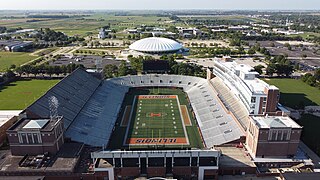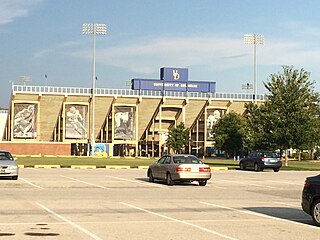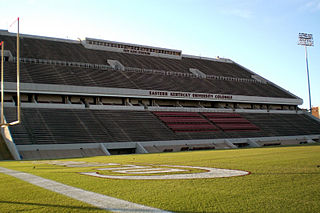
Worcester Polytechnic Institute (WPI) is a private research university in Worcester, Massachusetts. Founded in 1865, WPI was one of the United States' first engineering and technology universities and now has 14 academic departments with over 50 undergraduate and graduate degree programs in science, engineering, technology, management, the social sciences, and the humanities and arts. WPI awards bachelor's, master's and Ph.D. degrees for the completion of these programs. It is classified among "R2: Doctoral Universities – High research activity".

CEFCU ('sef-kyü) Stadium, formerly known as Spartan Stadium, is an outdoor athletic stadium on the west coast of the United States, located in the Spartan Keyes neighborhood of central San Jose, California. Owned by San José State University, the venue is the longtime home of Spartan football; it also hosts the university's commencement ceremony on Memorial Day weekend, and occasional high school football games. Known as Spartan Stadium for over eight decades, it was renamed in 2016.

Memorial Stadium is a stadium on the campus of the University of Illinois Urbana-Champaign in Champaign, Illinois, United States. The stadium, used primarily for football, is a memorial to the university's students who died in World War I; their names are engraved on the nearly 200 pillars surrounding the stadium's façade. With a capacity of 60,670, the stadium is primarily used as the home of the university's Fighting Illini football team.

Rice–Eccles Stadium is an outdoor college football stadium located on the campus of the University of Utah in Salt Lake City, Utah. It is the home field of the Utah Utes of the Pac-12 Conference. It served as the main stadium for the 2002 Winter Olympics; the Opening and Closing Ceremonies were held at the stadium, which was temporarily renamed "Rice–Eccles Olympic Stadium".
Dragon Stadium is a stadium in Southlake, Texas. It is used mostly for American football games. The stadium is Located at 1085 S. Kimball Ave. in Southlake, Texas, the stadium serves Carroll ISD, and is the home of the Carroll Senior High School Dragons football team. The stadium was used by the Major League Soccer club Dallas Burn for the 2003 season, after having used the Cotton Bowl since its founding in 1996.

Memorial Stadium is a stadium in Bloomington, Indiana, United States. It is primarily used for football, and has been the home of Indiana Hoosiers football since its opening in 1960. It is the tenth largest stadium in the Big Ten Conference, with a capacity of 52,626. The field has a conventional north-south alignment, at an approximate elevation of 771 feet (235 m) above sea level.
Plaster Stadium is a 17,500-seat football stadium located in Springfield, Missouri. It is home to the Missouri State Bears football team.

Delaware Stadium is a 22,000-seat multi-purpose stadium in Newark, Delaware, and is home to the University of Delaware Fightin' Blue Hens football team. The stadium is part of the David M. Nelson Athletic Complex, which includes the Bob Carpenter Center, Fred P. Rullo Stadium, the Fred Rust Ice Arena and the Delaware Field House.

CG Bank Field at Roy Kidd Stadium is Eastern Kentucky University's football stadium in Richmond, Kentucky. The stadium is home to the EKU Colonels football team, located on campus. Currently, CG Bank Field at Roy Kidd Stadium consists of upper and lower-level seating areas, with a predominant majority of the seats being metal bleachers. Reserved chairback seats can be found in the middle of the lower level, as well, the seats are generally purchased by season ticket holders and Eastern Alumni.

Roos Field is an outdoor college football stadium in the northwest United States, on the campus of Eastern Washington University in Cheney, Washington, southwest of Spokane. It is the home venue of the Eastern Washington Eagles of the Big Sky Conference in Division I (FCS).

Cameron Stadium is an outdoor football stadium adjacent to the campus of Washington & Jefferson College in Washington, Pennsylvania.
Robert Rice Stadium was an outdoor athletic stadium in Salt Lake City, Utah, located on the campus of the University of Utah. Originally opened in 1927 as Ute Stadium, it was the home of the Utah Utes football team. Renamed for Robert L. Rice in 1972, it was almost completely demolished after the 1997 season to make way for the Utes' current home, Rice-Eccles Stadium, which occupies the same physical footprint.

The WPI Engineers are the athletic teams of Worcester Polytechnic Institute. The school sponsors 20 varsity sports.

The WPI Engineers football team represents Worcester Polytechnic Institute (WPI) in the sport of American football. The Engineers compete in Division III (DIII) of the National Collegiate Athletics Association (NCAA) and the NEWMAC. WPI's football program is one of the oldest in the country. The team has been coached by Chris Robertson since the 2010 season.

The 2015 WPI Engineers football team represented Worcester Polytechnic Institute in the 2015 NCAA Division III football season. It marked the Engineers' 126th overall season and the team played its home games at Alumni Stadium in Worcester, Massachusetts. They were led by sixth year head coach Chris Robertson. They were a member of the Liberty League.

The 1992 WPI Engineers football team represented Worcester Polytechnic Institute in the 1992 NCAA Division III football season. It marked the Engineers' 103rd overall season and the team played its home games in Worcester, Massachusetts. They were led by fifth-year head coach Jack Siedlecki. They were a member of the Freedom Football Conference (FFC). The Engineers finished the season 9–2 and earned the school's first-ever bid to the NCAA Division III Football Championship playoffs.

The WPI Engineers men's basketball team is the college basketball program representing Worcester Polytechnic Institute (WPI). The Engineers compete in the Division III (DIII) of the National Collegiate Athletics Association (NCAA) and the NEWMAC. WPI's men's basketball program began competing regularly as a varsity sport in 1918. The team is currently coached by Chris Bartley.

The 2017 WPI Engineers football team represented Worcester Polytechnic Institute in the 2017 NCAA Division III football season. It marked the Engineers' 128th overall season. The team played its home games at Alumni Stadium in Worcester, Massachusetts. They were led by eighth-year head coach Chris Robertson. This was the first season that WPI competed in the New England Women's and Men's Athletic Conference (NEWMAC) for football.

The RPI–WPI football rivalry is an American college football rivalry between the RPI Engineers of Rensselaer Polytechnic Institute and the WPI Engineers of Worcester Polytechnic Institute. The two teams have played regularly since their first meeting in 1894, making it one of the oldest rivalries in college football history. The series was played uninterrupted from 1947 until 2020, when it was interrupted by the COVID-19 pandemic. Following the teams' 1979 meeting, the schools agreed to award a transit to the winning team; having become a tradition since 1980.
Alumni Gymnasium, or Alumni Gym, was a multipurpose athletic complex on the Worcester Polytechnic Institute (WPI) campus in Worcester, MA. The gym had an indoor track, a basketball court, a swimming pool, a fitness center, a bowling alley, locker rooms, and athletic offices. The gym was closed in 2012 when the Institute opened a new recreation center. In 2016, with the approval of the Worcester Historical Commission, the 100-year-old building was razed to make way for the Foisie Innovation Studio.















